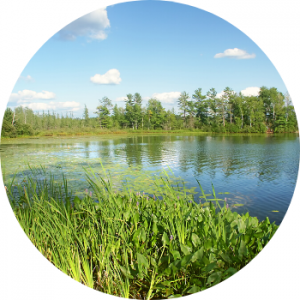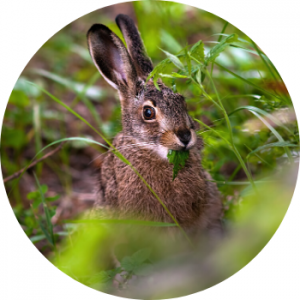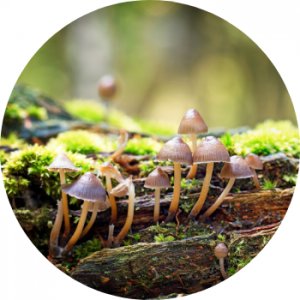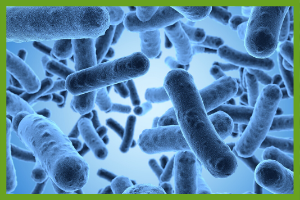Lots of people are familiar with the water cycle, but how about nutrient cycles? How does nitrogen move through an ecosystem?
Imagine this scenario:
- A plant absorbs nitrogen from the soil,
- through photosynthesis, it is used to produce green leaves,
- the leaves are eaten by a grasshopper,
- the grasshopper is eaten by a small bird,
- the small bird is eaten by a hawk,
- and then the hawk dies of old age.

But what happens to the original nitrogen molecule throughout this journey? The sustainable process known as the web of life requires producers, consumers, and decomposers.
Decomposers live off dead material and recycle nutrients into the soil for reuse by plants. Did you ever consider the fact that if we did not have decomposers in our natural environment, we would be surrounded by death and detritus? While that is not a very pleasant thought, it is true. We need producers, consumers, and decomposers to make the web of life complete.
Use these STEM activities to help students discover that the final link in the food chain is also the “first” link.
These enrichments accompany Activity 24, Nature’s Recyclers, found in Project Learning Tree’s PreK-8 Environmental Education Activity Guide. Be sure to check out the full activity!
Essential Question: What are the primary roles of producers, consumers, and decomposers?

Task: Create a multi-media display that details the roles and responsibilities of producers, consumers, and decomposers found in your local area.
NGSS Connections:
- 3-LS1-1. From molecules to Organisms: Structures and Processes – Develop models to describe that organisms have unique and diverse life cycles but all have in common birth, growth, reproduction, and death.
- 5-LS2-1. Ecosystems: Interactions, Energy, and Dynamics – Develop a model to describe the movement of matter among plants, animals, decomposers, and the environment.
- MS-LS2-3. Ecosystems: Interactions, Energy, and Dynamics – Develop a model to describe the cycling of matter and flow of energy among living and nonliving parts of an ecosystem
STEM Strategies
Science

Ecosystems are characterized by the interactions between their living (plants, animals, organisms) and non-living (soil, sun, climate) component parts. Producers, consumers, and decomposers are found within an ecosystem. Producers (such as grass and kelp) create their own food using the energy from the sun. Consumers get the energy they need by eating green plants (herbivores), animals (carnivores), or both (omnivores). Decomposers are responsible for consuming and recycling dead organisms and waste into non-living elements.
Use this 6-and-a-half-minute video to learn about the characteristics of producers, consumers, and decomposers and the roles they play in an ecosystem.
Technology
Producers, consumers, and decomposers are found everywhere. Watch this video from the Pacific Northwest region of the United States to see how many producers, consumers, and decomposers you can spot. Pause the video at any time and use the graphic organizer – template provided below, adding additional rows as necessary — to practice recording example field data.
After practicing with the video, take a trip outside and explore your local ecosystem. Use a digital video or camera to collect pictures of producers, consumers, and decomposers found in your area. Sort your collection of images and videos into the same three categories from the template graphic organizer. Which did you find the most of? Why do think there are more of these in your local ecosystem?

Engineering

Bioremediation uses decomposers to help clean up an environment that has been damaged by contaminants or pollution. Microorganisms consume and breakdown environmental pollutants. They have been used to help clean up oil spills as described in these articles from Scientific American about Deepwater Horizon and Exxon Valdez.
Because of the extensive spillage, small oil traces continue to persist. What might biological engineers design to enhance or amplify the use of decomposers in these areas to create oil-free environments?
Draft a bioremediation plan that describes:
- An overview of the remediation program
- Details about how funds will be spent
- Where and when remediation will occur
- How remediation will take place
- Measurements of success

Challenge students to think of other pollution scenarios in which engineers could use bioremediation as a viable solution. Have them write or draw how an engineer would use decomposers (and which ones) in that scenario to return the environment to a healthier condition.
For high schools students, check out Activity 2, Bioremediation in PLT’s Biotechnology module. In this activity, students will learn how living organisms have been used traditionally to process materials or to produce certain products or results. Students will also explore how modern bioengineering techniques have been used to mimic natural processes for the cleanup of sewage, oil spills, and other environmental toxins.
Math
Many people assume that math requires conducting calculations that demand a desk or computer setting. But who says math can’t be fun? Did you know that math can be applied to support outdoor scientific sampling AND exercise your right to play in the dirt?? The Great Lakes Worm Watch offers resources that can help you calculate the density of earthworms in soil. Earthworms are classified as decomposers because they eat dead or decaying organic matter. All you need to get started is a tape measure (English or metric scale), 8 popsicle sticks (or another way to mark the corners of the sampling plot), a hand trowel, and a bucket!
Additional Resources:
Don’t have PLT’s PreK-8 Environmental Education Activity Guide?
- Purchase a print guide or e-book, available from PLT.org, Amazon and other places where books are sold.
- Get it through your PLT State Coordinator along with hands-on professional development, alignments to state standards and other state-specific supporting resources.
Don’t consider yourself a formal teacher?
- Check out PLT’s Nature Activities for Families. We have 40+ nature activities for families that can be easily used by parents, grandparents, youth group leaders, nature centers, and other nonformal programs.





One comment on “STEM: Nature’s Recyclers”
Dr. Irwin,
Thank you very much. This is very good “Stuff”.
Hope that your Holidays are filled with smiles
Jerry